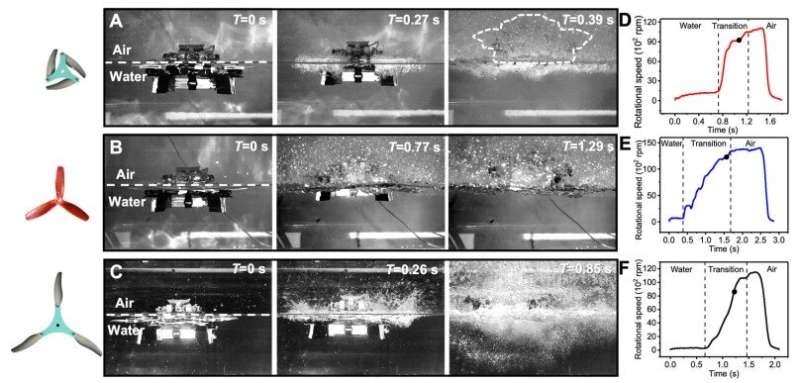May 19, 2022 report
A quadcopter that works in the air and underwater and also has a suction cup for hitching a ride on a host

A team of researchers at Beihang University, working with colleagues at Imperial College London and Swiss Federal Laboratories for Materials Science and Technology, has developed a quadcopter drone that is capable of flying in the air and maneuvering underwater. It also has a suction cup for hitching a ride on a host. They describe their drone in the journal Science Robotics.
Over the past several years, quadcopters have become a consumer product. And while the technology behind them is quite impressive, one drawback is their inability to survive a water landing. In this new effort, the researchers have not only overcome that problem, but they have also given their robot the ability to maneuver underwater and to hitch itself to undersea creatures.
Noting that quadcopters can still only fly for short periods of time, the researchers looked into the feasibility of a drone that could hitch a ride, similar to the remora fish. Remoras have a suction disc that allows them to attach to other fish, sharks and whales, thus conserving energy. To that end, the researchers created a suction disc modeled after the one sported by the remora.
To do so, they created a sandwich of four layers using a 3D printer. The layer on top was flexible, while those underneath were less so. They also added small channels to the underlayers that could be pumped full of water. The design allowed the robot to adhere to nearly any surface, wet or dry, and to remain attached even if part of the disc came free. A small motor was added to pump water in and out of the disc and another to control its angle of attack. The researchers also added waterproofing to the drone and modified the propellers to fold automatically when encountering water. The result was a quadcopter drone that can fly as normal in the air and that also maneuvers under the water. And when it sticks to a fish, shark or whale, it can travel for miles without using battery power. The drone can also let go of its host, swim to the surface and fly out of the water.
More information: Lei Li et al, Aerial-aquatic robots capable of crossing the air-water boundary and hitchhiking on surfaces, Science Robotics (2022). DOI: 10.1126/scirobotics.abm6695
© 2022 Science X Network




















